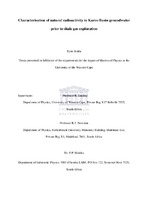| dc.description.abstract | The prospect of unconventional shale-gas development in the Karoo Basin (South Africa) has created
the need to obtain baseline data on natural radioactivity in Karoo groundwaters. The Karoo Basin
groundwater radiological baseline developed through this study could serve as a reference to research
potential future radiological contamination effects due to hydraulic fracturing. The major naturally
occurring radioactive material (NORM) studied was radon (222Rn), in particular in-water activity
concentrations; however, supplementary radium (226Ra and 228Ra) in-water activity concentrations and
uranium (238U) in-water concentrations measurements were also made. A total of 53 aquifers across
three provinces were sampled for groundwater and measured, with three measurement series from
2014 to 2016. The aquifers were categorized as shallow, mixed, or deep source. The radon-in-water
baseline of the Karoo Basin can be characterised by a minimum of 0.6 ± 0.9 Bq/L, a maximum of 183
± 18 Bq/L and mean of 41 ± 5 Bq/L. The radon-in-water levels from shallow sources (with water
temperature < 20 °C) were systematically higher (40 Bq/L) than for deep sources (with water
temperature > 20 °C). The natural fluctuations in radon-in-water levels were predominantly associated
with shallow aquifers compared to almost none observed in the deep sources. The uranium in-water
baseline can be characterised by a minimum of below detection level, a maximum of 41 μg/L, and the
mean of 5.10 ± 0.80 μg/L. Similar to radon-in-water levels, uranium in-water levels for shallow
sources were systematically higher than for deep sources. The limited (six aquifers) radium (228Ra and
226Ra) in-water activity-concentration measurement results were very low, with a maximum of 0.008
Bq/L (226Ra) and 0.015 Bq/L (228Ra). The 228Ra/226Ra ratio baseline were characterised by a minimum
of 0.93, a mean of 3.3 ± 1.3, and a maximum of 6.5. The radium isotopes’ activity concentration ratio
is an isotopic tracer for hydraulic fracturing wastewater. Pollution and contamination (radiological),
due to unconventional shale gas development, in water resources has been noticed in the Marcellus
Basin (United States). Consequently, developing and improving continuous baseline monitoring are of
importance to study the environmental radiological effect of hydraulic fracturing. | |

